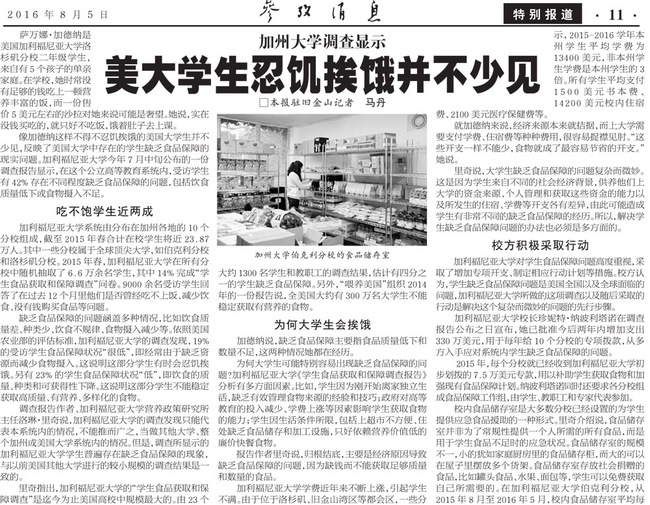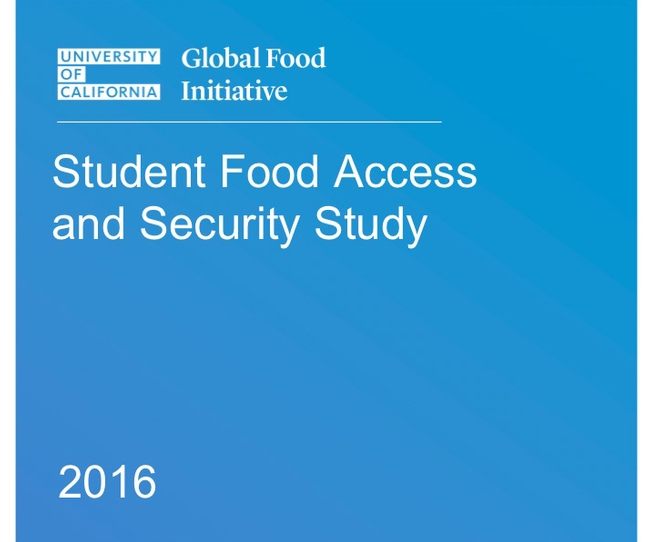Posts Tagged: Lorrene Ritchie
Chinese newspaper shares UC food insecurity research
Xinhua News is the official press agency of the Peoples Republic of China. It has a news bureau in San Francisco. The story came after UC President Janet Napolitano approved $3.3 million in new funding over the next two years to help students regularly access nutritious food on campus and off. The allocation was prompted by the results of a 2015 UC survey designed to accurately gauge the food security of its students. Survey responses were evaluated by NPI, part of UC Agriculture and Natural Resources.
According to the survey, 19 percent of UC students indicated they had "very low" food security. An additional 23 percent were characterized as having "low" food security.
"I think many people in China think about food security in a little different way," wrote Dan in her email to Ritchie. "They care more about if there's food to fill their stomach and are less likely to realize that the reduced size of meals, less nutritious food, diet lacking variety and irregular eating patterns may constitute food insecurity. Maybe that's why some editors just don't believe that food security could be a broad issue in American universities."
Ritchie told Dan that is also a common misperception among people in the U.S.
"Food insecurity should not be confused with severe forms of starvation. Food insecurity is defined by the U.S. Department of Agriculture," Ritchie said.
According to USDA definitions, "very low" food security is experienced as reduced food intake at times during the past year due to limited resources, and "low" food security is reduced quality, variety or desirability of the diet, with little or no indication of reduced food intake.
Dan got further clarification when she asked about her own personal experience.
"I'm constantly under work pressure and deadline pressure and don't have time to prepare food. As a result, I often skip meals, have poor quality diet and irregular eating patterns. Do you think I have the problem of food insecurity?" Dan wrote.
Ritchie explained: "You, like many, may not eat optimally for a number of reasons. But to be classified as food insecure, your inability to eat a more nutritious diet and follow a more regular eating pattern has to be due to a lack of financial resources, rather than lack of time."
UC commits $3.3 million to improve student access to nutritious food
Guided by the findings of a survey conducted by UC ANR's Nutrition Policy Institute, UC President Janet Napolitano announced July 11 she would commit $3.3 million in new funding over the next two years to help UC students regularly access nutritious food. UC's survey findings and response were reported by the San Francisco Chronicle, East Bay Times, Los Angeles Times, KCBS and KPCC.
The online survey was administered to a randomly selected sample of students from all 10 UC campuses in spring 2015. It is part of the UC Global Food Initiative, which promotes a nutritious, sustainable food supply.
According to the NPI survey, 19 percent of the nearly 9,000 participating UC students indicated they had “very low” food security, which the USDA defines as experiencing reduced food intake at times due to limited resources. An additional 23 percent were characterized as having “low” food security, defined by the USDA as reduced quality, variety or desirability of diet, with little or no indication of reduced food intake.
“I wasn't expecting that level of food insecurity in students,” said NPI director Lorrene Ritchie, who led the study, to Jessie Qian of the Daily Californian. “Adults who aren't informed would think students are just passive, spending their money on other things or just complaining … but it's really that big of a problem.”
According to the UC news release, UC has developed an action plan tailored to the needs of individual campuses while maximizing coordination among them. The plan includes:
- Expanding food pantry storage and access
- Increasing collaboration with state and county offices to register students for CalFresh, California's nutrition assistance program
- Establishing and expanding awareness campaigns on student support services and food access
- Expanding the existing Swipe Out Hunger programs, which allow university students to donate excess dollars on their meal plan to reduce hunger on campuses
- Integrating food preparation and secure storage space into new student housing design and construction
- Enhancing financial aid communications about housing and food costs
“Among students who reported food insecurity in the past year, we found that for 57 percent this was a new experience – not one they had faced as children,” says Ritchie. “This suggests that students who are on their own for the first time would benefit from financial literacy training and additional information about financial aid, nutrition assistance, and making healthy choices on a limited budget.”
The report Student Food Access and Security Study, authored by NPI research analyst Suzanna Martinez, UC Santa Barbara sustainability coordinator Katie Maynard and Ritchie, can be downloaded at http://npi.ucanr.edu.
The debate over dairy products is being milked for all its worth
Since the 1960s, nutrition experts have encouraged Americans to forgo whole milk in favor of skim or low-fat dairy products. Now some scientists are saying the move to low-fat dairy is tied to the country's obesity crisis, according to an article in The Guardian
Robert Lustig, professor of pediatric medicine at UC San Francisco, said he believes drinking whole milk can lead to lower calorie intake overall because it is more filling than low-fat and non-fat alternatives.
A UC Agriculture and Natural Resources (UC ANR) expert shared a different viewpoint. Lorrene Ritchie, director of the UC ANR Nutrition Policy Institute, said low-fat or skim milk products are still preferable to whole milk because liquid calories are not as filling as equivalent calories from solid food. Nationwide, the goal for most people should be to reduce calorie intake.
"Until we decrease calorie intake on a population level, we are unlikely to see much reversal in the obesity epidemic," Ritchie said.
Before the end of 2015, the federal government is expected to release its revised Dietary Guidelines for Americans. According to the Guardian article, the guidelines are expected to tout vegetables, fruits, whole grains, legumes, nuts, seafood and "low- or non-fat dairy." The guidelines inform the USDA's dietary infographic, which at the moment takes the form of a plate half filled with vegetables and fruit, and the other half with a small portion of protein food and whole grains.
The Nutrition Policy Institute has been advocating for the addition of water on the MyPlate icon to reinforce its position that plain tap water is the best choice for quenching thirst.





